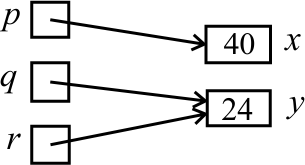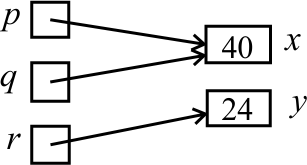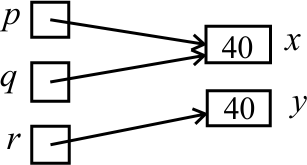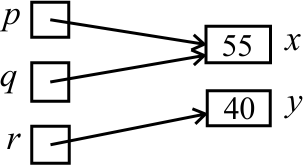|
The only sensible way to deal with pointers is to draw diagrams. If pointer variable p contains the address of x, then we say that p points to x, and we show an arrow from p to x.
Let's simulate the following pointless sequence of statements just for practice. For reference, the lines are numbered.
1. int x = 40; 2. int y = 24; 3. int* p = &x; 4. int* q = &y; 5. int* r = q; 6. q = p; 7. *r = *q; 8. *p = 55; 9. p = r;
The following diagram shows the variables after the first 5 lines.

Line 6, copies the pointer that is p into q, making q point to the same place as p.

Line 7 sets *r (currently the same as y) to hold the value that is in *q (currently x).

Line 8 sets *p (currently the same as x) to hold 55.

Line 9 copies the pointer in r (which currently points to y) into pointer variable p, making p also point to y.

You should be able to draw your own pointer diagrams and hand simulate a sequence of statements like the ones just done. The most important thing is: Don't cut corners. Draw your pointer diagrams carefully. Never try to hand-simulate pointer operations in your head. You will miss important details.
What is the value of variable x after performing the following sequence of statements?
int x = 50; int* p = &x; *p = 4;Answer
What is the value of x after doing
int y = 7; int x = 35; int* p = &x; p = &y;Answer
What is the value of variable x after performing the following sequence of statements?
int x = 20; int y = 41; int z = 60; int* p = &x; int* q = &y; int* r = &z; *r = *q; q = p; *q = *r;Answer
|